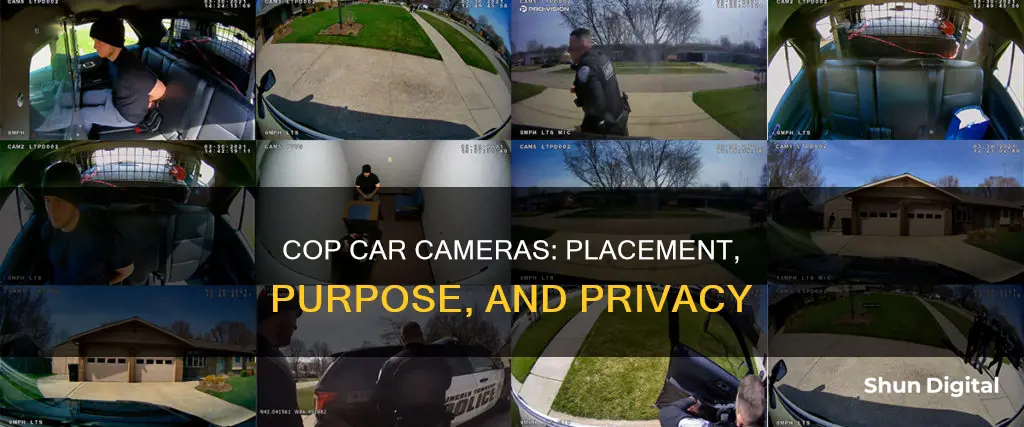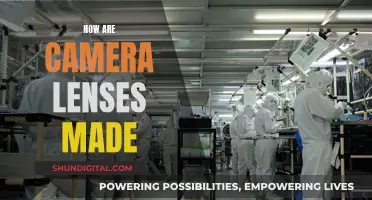
Police car cameras are an increasingly common feature of law enforcement, with nearly 72% of state patrol vehicles now utilizing this technology. These cameras are typically hardwired into a vehicle's electrical system, allowing them to be activated by certain triggers, such as the turning on of emergency lights and sirens. They can also be manually activated by an officer. The cameras are positioned to provide a broad view of the activity surrounding the vehicle, with some systems offering a 270-degree panoramic view. In addition to exterior cameras, interior cameras are used to monitor the back seat and can be equipped with night vision capabilities. The footage captured by these cameras serves as digital evidence, aiding in investigations, increasing transparency, and providing protection for both officers and citizens.
| Characteristics | Values |
|---|---|
| Number of Cameras | 5 |
| Camera Locations | Front, back, sides, inside |
| Camera Functions | HD video, high-fidelity audio, license plate recognition, night vision, live streaming |
| Activation | Manual, automatic (when lights are on, certain speed is reached, or when the car is turned on) |
| Recording Capacity | 40 hours of video |
| Storage | Cloud-connected hub, high-capacity storage |
What You'll Learn

Cameras can be triggered by police lights/siren
Police car camera systems are designed to automatically record video and audio when triggered by specific events, such as the activation of the police lights or siren. This technology ensures a comprehensive and objective record of an officer's encounters, serving as valuable evidence in court and increasing accountability by monitoring their activities.
The camera system in police cars can have up to five separate cameras, providing a panoramic view of the surrounding area. These cameras are strategically positioned to capture a broad perspective, including a front-facing camera, a rear-facing camera, and two side-mounted cameras built into the light bar. The fifth camera is dedicated to monitoring the back seat, ensuring the constant surveillance of prisoners.
The automatic recording feature of these camera systems is a significant advantage, ensuring that critical moments are captured without requiring manual activation by the officer. The system is designed to be always ready, with the cameras starting to record video as soon as the police car is turned on. This continuous recording capability allows for the capture of up to 40 hours of video footage, providing a valuable buffer that can be reviewed if necessary.
The cameras can be triggered by the activation of the police lights or siren, ensuring that any incident that occurs during a traffic stop or emergency response is recorded. This automatic trigger function enhances the system's effectiveness and reliability, capturing crucial footage and audio without the need for manual intervention.
Additionally, the camera system offers audio recording capabilities, further enhancing the context of the recorded events. The officer wears a microphone that transmits audio back to the car, even when they are out of the camera's direct line of sight. This feature ensures that conversations between officers, members of the public, and any other relevant audio cues are captured and synchronised with the video footage.
Testing Your Camera on Your Computer: A Step-by-Step Guide
You may want to see also

Cameras can be manually activated by officers
Police car cameras are typically hardwired into a vehicle's electrical system, allowing them to be activated by specific triggers, such as turning on emergency lights and sirens. However, in certain situations, officers may need to manually activate the cameras. This manual activation ensures that officers have control over their equipment and can capture crucial footage when necessary.
In some cases, dash cameras may not automatically turn on with the triggers, requiring officers to manually start recording. This feature ensures that officers can proactively capture footage when they anticipate a situation requiring evidence collection or increased transparency. For instance, if an officer pulls over a vehicle for a traffic violation, they can manually activate the camera to record the interaction.
The manual activation of cameras in police cars is particularly important when dealing with situations that may not trigger automatic recording. For example, if an officer is responding to a disturbance call and does not activate their emergency lights, they can manually turn on the camera to record their approach and interaction with individuals at the scene. This proactive measure ensures that critical incidents are captured on film.
Additionally, manual activation can be useful when an officer wants to record specific details that may not be covered by automatic triggers. For instance, if an officer notices suspicious behaviour or a potential crime in progress, they can manually start recording to capture the incident. This proactive approach ensures that potential evidence is not missed, even if the situation does not escalate to the point of activating emergency lights or high speeds.
The ability for officers to manually activate cameras in their vehicles empowers them to take control of their surroundings and ensure that critical incidents are recorded. This functionality complements automatic triggers and provides an added layer of protection for both officers and citizens. By manually activating their cameras, officers can proactively gather evidence, increase transparency, and improve the overall effectiveness of their duties.
Advanced Car Camera Systems: Braking Innovations and Features
You may want to see also

Cameras can be automatically activated by speed
Police car cameras can be automatically activated by speed. For example, the Palo Alto police department's fleet of 26 cars is equipped with a multiple-camera video system that automatically starts recording video when the car is turned on. The system also has preset automatic triggers, including when the car goes over 80 miles per hour. This means that the cameras can be activated by the speed of the police car itself, providing an objective record of what the officer encounters. The recordings are used as evidence in court and can also increase accountability by monitoring officer activity.
The camera system in Palo Alto police cars has five separate cameras that provide high-definition video and high-fidelity audio. One camera is positioned at the front windshield, similar to a traditional dashboard camera, while another faces out the back. Two cameras are mounted on the sides of the car and are built into the light bar. The fifth camera is focused on the back seat, where a prisoner might be seated.
The system offers significant advantages to the police department. The cameras provide a broad view of the activity surrounding the vehicle, with a 270-degree field of vision. This panoramic view enhances situational awareness and officer safety during incidents. Additionally, the audio and video recordings protect both the officers and the public. They serve as evidence against frivolous complaints and provide accountability for any officer impropriety.
The automatic activation of cameras based on speed is a valuable feature for law enforcement. It ensures that critical events are captured on camera, even if the officer has not manually activated the recording. This capability contributes to the overall effectiveness of the camera system in police cars, promoting transparency, accountability, and the safety of both officers and the public.
Login to Your Momentum Camera via Computer
You may want to see also

Cameras can be used for training purposes
Cameras on Cop Cars for Training Purposes
Cameras on police cars, or dashcams, are an increasingly common feature of police vehicles. They can be used for training purposes, to improve officer performance, and to increase accountability and transparency. In-car camera systems can provide a panoramic view, with multiple cameras offering a 270-degree view of the surrounding area. This can be invaluable for training new officers, as it provides an objective record of an officer's experience and encounters.
Body-worn cameras are also becoming more common, with many police departments adopting this technology. These can be used in conjunction with in-car systems to provide a more complete picture of an officer's experience. Footage from body-worn cameras can be used to provide feedback and constructive criticism to new officers, helping them to learn from their peers and identify best practices. This type of training is cost-effective and can be easily implemented with a systematic approach. It also has the added benefit of providing continuing education credits for officers.
The footage from these cameras can be used to review recorded encounters, providing an opportunity to inform future decision-making and shed light on both positive and negative interactions with citizens. This can help officers learn from each other and improve their performance. For example, footage can be used to illustrate successful de-escalation techniques, with officers summarising the methods used and how they could be applied in future scenarios.
In addition to training, the footage can also be used to enhance accountability and transparency. For instance, in the trial of Derek Chauvin, the footage from body-worn cameras provided valuable evidence of the killing of George Floyd and was extensively used by both prosecution and defence attorneys. This type of footage can also help to reduce the prevalence of misconduct and improve fairness in policing, as well as reduce the use of force by police.
Focusing Your LG K20 V Camera: Tips and Tricks
You may want to see also

Cameras can be used for automatic license plate recognition (ALPR)
Cameras on police cars can be used for automatic license plate recognition (ALPR). ALPR is a technology that uses optical character recognition on images to read vehicle registration plates and create vehicle location data. It can be used to check if a vehicle is registered or licensed, for electronic toll collection, and to catalogue the movements of traffic. ALPR systems are typically mounted on street poles, streetlights, highway overpasses, mobile trailers, or attached to police cars.
The cameras used for ALPR can be existing closed-circuit television, road-rule enforcement cameras, or cameras specifically designed for license plate recognition. These cameras often use infrared lighting to capture clear images of license plates at any time of day or night.
ALPR systems automatically capture all license plate numbers that come into view, along with the location, date, and time. The data collected includes photographs of the vehicle and sometimes its driver and passengers. This data is then uploaded to a central server, where it can be accessed and analysed by law enforcement agencies.
The use of ALPR in police cars provides several benefits for law enforcement. It enables officers to capture data from license plates while on patrol, allowing them to identify stolen vehicles, wanted felons, or vehicles associated with outstanding warrants. It also assists in traffic management by monitoring the flow of vehicles and providing information about travel patterns. Additionally, ALPR data can be used as evidence in court proceedings, increasing accountability and transparency in police operations.
However, the use of ALPR also raises privacy concerns. The data collected by ALPR systems can reveal intimate details about an individual's life, including their travel patterns and locations they frequent. There have been instances of ALPR data being misused by law enforcement, such as targeting religious or ethnic minority communities. Critics argue that ALPR amounts to mass surveillance and invades the privacy of citizens.
To address these concerns, it is important to have strict policies and regulations governing the use and retention of ALPR data. This includes limiting data storage periods, restricting access to authorised personnel, and ensuring that data is only collected for legitimate law enforcement purposes. Additionally, independent oversight and accountability measures should be implemented to prevent misuse and protect the rights of citizens.
Charging Camera on the Go: Alternative Power Sources
You may want to see also
Frequently asked questions
There are multiple cameras on a cop car, with one typically facing out of the front windshield, one facing out the back, and two mounted on the sides of the car.
These cameras are part of an automatic license plate reader (ALPR) system. They snap pictures of license plates and a computer in the car looks up the vehicle's registration.
Police car cameras are hardwired into a vehicle's electrical system, so they can be activated by triggers such as when a police officer turns on their emergency lights and siren. In some cases, an officer may still need to manually activate the camera.
Police car cameras provide additional visibility for officers and supervisors, allow for greater community transparency, and generate admissible evidence. They can also help keep officers safe, with 48% of police officers reporting that the presence of a police dash camera allowed them to de-escalate encounters by pointing out that they were being recorded.







